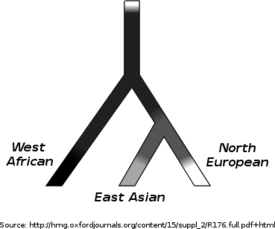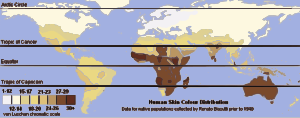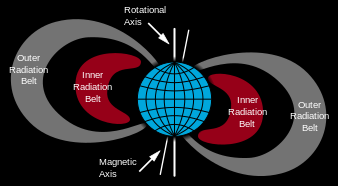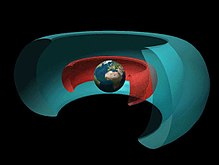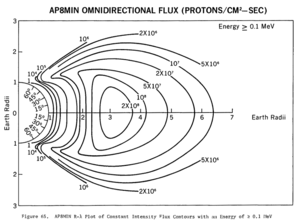Extended Coloured family from South Africa showing some spectrum of human skin coloration
Human skin color ranges in variety from the darkest brown to the lightest hues. An individual's skin pigmentation is the result of genetics, being the product of both of the individual's biological parents' genetic makeup. In evolution, skin pigmentation in human beings evolved by a process of natural selection primarily to regulate the amount of ultraviolet radiation penetrating the skin, controlling its biochemical effects.[1]
The actual skin color of different humans is affected by many substances, although the single most important substance is the pigment melanin. Melanin is produced within the skin in cells called melanocytes and it is the main determinant of the skin color of darker-skinned humans. The skin color of people with light skin is determined mainly by the bluish-white connective tissue under the dermis and by the hemoglobin circulating in the veins of the dermis. The red color underlying the skin becomes more visible, especially in the face, when, as consequence of physical exercise or the stimulation of the nervous system (anger, fear), arterioles dilate.[2] Color is not entirely uniform across an individual's skin; for example, the skin of the palm and the sole is lighter than most other skin, and this is especially noticeable in darker-skinned people.[3]
There is a direct correlation between the geographic distribution of ultraviolet radiation (UVR) and the distribution of indigenous skin pigmentation around the world. Areas that receive higher amounts of UVR, generally located closer to the equator, tend to have darker-skinned populations. Areas that are far from the tropics and closer to the poles have lower intensity of UVR, which is reflected in lighter-skinned populations.[4] Researchers suggest that human populations over the past 50,000 years have changed from dark-skinned to light-skinned and vice versa as they migrated to different UV zones,[5] and that such major changes in pigmentation may have happened in as little as 100 generations (≈2,500 years) through selective sweeps.[5][6][7] Natural skin color can also darken as a result of tanning due to exposure to sunlight. The leading theory is that skin color adapts to intense sunlight irradiation to provide partial protection against the ultraviolet fraction that produces damage and thus mutations in the DNA of the skin cells.[8][9] In addition, it has been observed that adult human females on average are significantly lighter in skin pigmentation than males. Females need more calcium during pregnancy and lactation. The body synthesizes vitamin D from sunlight, which helps it absorb calcium. Females evolved to have lighter skin so their bodies absorb more calcium.[10]
The social significance of differences in skin color has varied across cultures and over time, as demonstrated with regard to social status and discrimination.
Melanin and genes
Melanin is produced by cells called melanocytes in a process called melanogenesis. Melanin is made within small membrane–bound packages called melanosomes. As they become full of melanin, they move into the slender arms of melanocytes, from where they are transferred to the keratinocytes. Under normal conditions, melanosomes cover the upper part of the keratinocytes and protect them from genetic damage. One melanocyte supplies melanin to thirty-six keratinocytes according to signals from the keratinocytes. They also regulate melanin production and replication of melanocytes.[7] People have different skin colors mainly because their melanocytes produce different amount and kinds of melanin.The genetic mechanism behind human skin color is mainly regulated by the enzyme tyrosinase, which creates the color of the skin, eyes, and hair shades.[11][12] Differences in skin color are also attributed to differences in size and distribution of melanosomes in the skin.[7] Melanocytes produce two types of melanin. The most common form of biological melanin is eumelanin, a brown-black polymer of dihydroxyindole carboxylic acids, and their reduced forms. Most are derived from the amino acid tyrosine. Eumelanin is found in hair, areola, and skin, and the hair colors gray, black, blond, and brown. In humans, it is more abundant in people with dark skin. Pheomelanin, a pink to red hue is found in particularly large quantities in red hair,[13] the lips, nipples, glans of the penis, and vagina.[14]
Both the amount and type of melanin produced is controlled by a number of genes that operate under incomplete dominance.[15] One copy of each of the various genes is inherited from each parent. Each gene can come in several alleles, resulting in the great variety of human skin tones. Melanin controls the amount of ultraviolet (UV) radiation from the sun that penetrates the skin by absorption. While UV radiation can assist in the production of vitamin D, excessive exposure to UV can damage health.
Evolution of skin color
Loss of body hair in Hominini species is assumed to be related to the emergence of bipedalism some 5 to 7 million years ago.[16] Bipedal hominin body hair may have disappeared gradually to allow better heat dissipation through sweating.[10][17]
Reconstruction of a female Homo erectus based on fossils dated c. 1.5 million years ago, the estimated time for the emergence of skin pigmentation in early humans (John Gurche, Smithsonian Museum of Natural History, 2010).
The emergence of skin pigmentation dates to after this, perhaps some 1.5 million years ago (about the time of the emergence of Homo heidelbergensis), when the earth endured a megadrought that drove early humans into arid, open landscapes. Such conditions likely caused excess UV-B radiation. This favored the emergence of skin pigmentation in order to protect from folate depletion due to the increased exposure to sunlight.[8][9] A theory that the pigmentation helped counter xeric stress by increasing the epidermal permeability barrier[18] has been disproved.[8]
With the evolution of hairless skin, abundant sweat glands, and skin rich in melanin, early humans could walk, run, and forage for food for long periods of time under the hot sun without brain damage due to overheating, giving them an evolutionary advantage over other species.[7] By 1.2 million years ago, around the time of Homo ergaster, archaic humans (including the ancestors of Homo sapiens) had exactly the same receptor protein as modern sub-Saharan Africans.[17]
This was the genotype inherited by anatomically modern humans, but retained only by part of the extant populations, thus forming an aspect of human genetic variation. About 100,000–70,000 years ago, some anatomically modern humans (Homo sapiens) began to migrate away from the tropics to the north where they were exposed to less intense sunlight. This was possibly in part due to the need for greater use of clothing to protect against the colder climate. Under these conditions there was less photodestruction of folate and so the evolutionary pressure working against the survival of lighter-skinned gene variants was reduced. In addition, lighter skin is able to generate more vitamin D (cholecalciferol) than darker skin, so it would have represented a health benefit in reduced sunlight if there were limited sources of vitamin D.[10] Hence the leading hypothesis for the evolution of human skin color proposes that:
- From about 1.2 million years ago to less than 100,000 years ago, archaic humans, including archaic Homo sapiens, were dark-skinned.
- As Homo sapiens populations began to migrate, the evolutionary constraint keeping skin dark decreased proportionally to the distance north a population migrated, resulting in a range of skin tones within northern populations.
- At some point, some northern populations experienced positive selection for lighter skin due to the increased production of vitamin D from sunlight and the genes for darker skin disappeared from these populations.
- Subsequent migrations into different UV environments and admixture between populations have resulted in the varied range of skin pigmentations we see today.
The theory suggests that the reduction of game meat, fish, and some plants from the diet resulted in skin turning light many thousands of years after settlement in Eurasia.[21] This theory is partially supported by a study into the SLC24A5 gene which found that the allele associated with light skin in Europe "determined […] that 18,000 years had passed since the light-skin allele was fixed in Europeans" but may have originated as recently as 12,000–6,000 years ago "given the imprecision of method" ,[22] which is in line with the earliest evidence of farming.[23]
Research by Nina Jablonski suggests that an estimated time of about 10,000 to 20,000 years is enough for human populations to achieve optimal skin pigmentation in a particular geographic area but that development of ideal skin coloration may happen faster if the evolutionary pressure is stronger, even in as little as 100 generations.[5] The length of time is also affected by cultural practices such as food intake, clothing, body coverings, and shelter usage which can alter the ways in which the environment affects populations.[7]
Reconstruction of the head of the Shanidar 1 fossil, a Neanderthal male who lived c. 70,000 years ago (John Gurche
2010). Examination of the genome of late Neanderthals suggests that at
least some populations may have developed light skin by 40,000 years
ago.[24]
One of the most recently proposed drivers of the evolution of skin pigmentation in humans is based on research that shows a superior barrier function in darkly pigmented skin. Most protective functions of the skin, including the permeability barrier and the antimicrobial barrier, reside in the stratum corneum (SC) and the researchers surmise that the SC has undergone the most genetic change since the loss of human body hair. Natural selection would have favored mutations that protect this essential barrier; one such protective adaptation is the pigmentation of interfollicular epidermis, because it improves barrier function as compared to non-pigmented skin. In lush rainforests, however, where UV-B radiation and xeric stress were not in excess, light pigmentation would not have been nearly as detrimental. This explains the side-by-side residence of lightly pigmented and darkly pigmented peoples.[18]
Population and admixture studies suggest a three-way model for the evolution of human skin color, with dark skin evolving in early hominids in Africa and light skin evolving partly separately at least two times after modern humans had expanded out of Africa.[19][25][26][27][28][29]
For the most part, the evolution of light skin has followed different genetic paths in Western and Eastern Eurasian populations. Two genes however, KITLG and ASIP, have mutations associated with lighter skin that have high frequencies in Eurasian populations and have estimated origin dates after humans spread out of Africa but before the divergence of the two lineages.[27]
Genetics
The evolutionary genetic architecture of skin pigmentation in Northern Europeans, West Africans and East Asians.
The understanding of the genetic mechanisms underlying human skin color variation is still incomplete, however genetic studies have discovered a number of genes that affect human skin color in specific populations, and have shown that this happens independently of other physical features such as eye and hair color. Different populations have different allele frequencies of these genes, and it is the combination of these allele variations that bring about the complex, continuous variation in skin coloration we can observe today in modern humans. Population and admixture studies suggest a 3-way model for the evolution of human skin color, with dark skin evolving in early hominids in sub-Saharan Africa and light skin evolving independently in Europe and East Asia after modern humans had expanded out of Africa.[19][25][26][27][28][29]
Dark skin
All modern humans share a common ancestor who lived around 200,000 years ago in Africa.[30] Comparisons between known skin pigmentation genes in chimpanzees and modern Africans show that dark skin evolved along with the loss of body hair about 1.2 million years ago and that this common ancestor had dark skin.[31] Investigations into dark skinned populations in South Asia and Melanesia indicate that skin pigmentation in these populations is due to the preservation of this ancestral state and not due to new variations on a previously lightened population.[10][32]- MC1R
- The melanocortin 1 receptor (MC1R) gene is primarily responsible for determining whether pheomelanin and eumelanin is produced in the human body. Research shows at least 10 differences in MC1R between African and chimpanzee samples and that the gene has probably undergone a strong positive selection (a selective sweep) in early Hominins around 1.2 million years ago.[33] This is consistent with positive selection for the high-eumelanin phenotype seen in Africa and other environments with high UV exposure.[31][32]
Light skin
For the most part, the evolution of light skin has followed different genetic paths in European and East Asian populations. Two genes however, KITLG and ASIP, have mutations associated with lighter skin that have high frequencies in both European and East Asian populations. They are thought to have originated after humans spread out of Africa but before the divergence of the European and Asian lineages around 30,000 years ago.[27] Two subsequent genome-wide association studies found no significant correlation between these genes and skin color, and suggest that the earlier findings may have been the result of incorrect correction methods and small panel sizes, or that the genes have an effect too small to be detected by the larger studies.[34][35]- KITLG
- The KIT ligand (KITLG) gene is involved in the permanent survival, proliferation and migration of melanocytes.[36] A mutation in this gene, A326G (rs642742[37]), has been positively associated with variations of skin color in African-Americans of mixed West African and European descent and is estimated to account for 15–20% of the melanin difference between African and European populations.[38] This allele shows signs of strong positive selection outside Africa[29][39] and occurs in over 80% of European and Asian samples, compared with less than 10% in African samples.[38]
- ASIP
- Agouti signalling peptide (ASIP) acts as an inverse agonist, binding in place of alpha-MSH and thus inhibiting eumelanin production. Studies have found two alleles in the vicinity of ASIP are associated with skin color variation in humans. One, rs2424984[40] has been identified as an indicator of skin reflectance in a forensics analysis of human phenotypes across Caucasian, African-American, South Asian, East Asian, Hispanic and Native American populations[41] and is about 3 times more common in non-African populations than in Africa.[42] The other allele, 8188G (rs6058017[43]) is significantly associated with skin color variation in African-Americans and the ancestral version occurs in only 12% of European and 28% of East Asian samples compared with 80% of West African samples.[44][45]
Europe
A number of genes have been positively associated with the skin pigmentation difference between European and non-European populations. Mutations in SLC24A5 and SLC45A2 are believed to account for the bulk of this variation and show very strong signs of selection. A variation in TYR has also been identified as a contributor.Research indicates the selection for the light-skin alleles of these genes in Europeans is comparatively recent, having occurred later than 20,000 years ago and perhaps as recently as 12,000 to 6,000 years ago.[27] In the 1970s, Luca Cavalli-Sforza suggested that the selective sweep that rendered light skin ubiquitous in Europe might be correlated with the advent of farming and thus have taken place only around 6,000 years ago;[22] This scenario found support in a 2014 analysis of mesolithic (7,000 years old) hunter-gatherer DNA from La Braña, Spain, which showed the version of these genes corresponding to dark skin color.[46] In 2015 researchers analysed for light skin genes in the DNA of 94 ancient skeletons ranging from 8,000 to 3,000 years old from Europe and Russia. They found c. 8,000-year-old hunter-gatherers in Spain, Luxembourg, and Hungary were dark skinned while similarly aged hunter gatherers in Sweden were light skinned (having predominately derived alleles of SLC24A5, SLC45A2 and also HERC2/OCA2). Neolithic farmers entering Europe at around the same time were intermediate, being nearly fixed for the derived SLC24A5 variant but only having the derived SLC45A2 allele in low frequencies. The SLC24A5 variant spread very rapidly throughout central and southern Europe from about 8,000 years ago, whereas the light skin variant of SLC45A2 spread throughout Europe after 5,800 years ago.[47][48]
- SLC24A5
Global frequency distribution of the SLC24A5 gene's ancestral Ala111 allele (yellow) and its derived Ala111Thr allele (blue).
- Solute carrier family 24 member 5 (SLC24A5) regulates calcium in melanocytes and is important in the process of melanogenesis.[49] The SLC24A5 gene's derived Ala111Thr allele (rs1426654[50]) has been shown to be a major factor in light skin pigmentation and is common in Western Eurasia.[41] Recent studies have found that the variant represents as much as 25–40% of the average skin tone difference between Europeans and West Africans.[19][51] This derived allele is a reliable predictor of phenotype across a range of populations.[52] It has been the subject of recent selection in Western Eurasia, and is fixed in European populations.[27][53][54]
- SLC45A2
- Solute carrier family 45 member 2 (SLC45A2 or MATP) aids in the transport and processing of tyrosine, a precursor to melanin. It has also been shown to be one of the significant components of the skin color of modern Europeans through its Phe374Leu (rs16891982[55]) allele that has been directly correlated with skin color variation in mixed-race populations.[41][52] This variation is ubiquitous in European populations but extremely rare elsewhere and shows strong signs of selection.[53][54][56]
- TYR
- The TYR gene encodes the enzyme tyrosinase, which is involved in the production of melanin from tyrosine. It has an allele, Ser192Tyr (rs1042602[57]), found solely in 40–50% of Europeans[19][27] and linked to light-colored skin in studies of both mixed-race South Asian[52] and African-American[58] populations.
East Asia
A number of genes known to affect skin color have alleles that show signs of positive selection in East Asian populations. Of these only OCA2 has been directly related to skin color measurements, while DCT, MC1R and ATTRN are marked as candidate genes for future study.- OCA2
Global frequency distribution of the OCA2 gene's ancestral allele (blue) and derived His615Arg allele (yellow).
- Oculocutaneous albinism II (OCA2) assists in the regulation of pH in melanocytes. The OCA2 gene's derived His615Arg (rs1800414[59]) allele has been shown to account for about 8% of the skin tone difference between African and East Asian populations in studies of an East Asian population living in Toronto and a Chinese Han population. This variant is essentially restricted to East Asia, with highest frequencies in Eastern East Asia (49–63%), midrange frequencies in Southeast Asia, and the lowest frequencies in Western China and some Eastern European populations.[28][60]
- Candidate Genes
- A number of studies have found genes linked to human skin pigmentation that have alleles with statistically significant frequencies in Chinese and East Asian populations. While not linked to measurements of skin tone variation directly, dopachrome tautomerase (DCT or TYRP2 rs2031526[61]),[62] melanocortin 1 receptor (MC1R) Arg163Gln (rs885479[63])[64] and attractin (ATRN)[19] have been indicated as potential contributors to the evolution of light skin in East Asian populations.
Tanning response
Tanning response in humans is controlled by a variety of genes. MC1R variants Arg151Sys (rs1805007[65]), Arg160Trp (rs1805008[66]), Asp294Sys (rs1805009[67]), Val60Leu (rs1805005[68]) and Val92Met (rs2228479[69]) have been associated with reduced tanning response in European and/or East Asian populations. These alleles show no signs of positive selection and only occur in relatively small numbers, reaching a peak in Europe with around 28% of the population having at least one allele of one of the variations.[32][70] A study of self-reported tanning ability and skin type in American non-Hispanic Caucasians found that SLC24A5 Phe374Leu is significantly associated with reduced tanning ability and also associated TYR Arg402Gln (rs1126809[71]), OCA2 Arg305Trp (rs1800401[72]) and a 2-SNP haplotype in ASIP (rs4911414[73] and rs1015362[74]) to skin type variation within a "fair/medium/olive" context.[75]Albinism
Oculocutaneous albinism (OCA) is a lack of pigment in the eyes, skin and sometimes hair that occurs in a very small fraction of the population. The four known types of OCA are caused by mutations in the TYR, OCA2, TYRP1, and SLC45A2 genes.[76]Age
In hominids the parts of the body not covered with hair, like the face and the back of the hands, start out pale in infants and turn darker as animals are exposed to more sun. All human babies are born pale, regardless of what their adult color will be. In humans, melanin production does not peak until after puberty.[7]The skin of children becomes darker as they go through puberty and experience the effects of sex hormones.[citation needed] This darkening is especially noticeable in the skin of the nipples, the areola of the nipples, the labia majora in females, and the scrotum in males. In some people, the armpits become slightly darker during puberty. The interaction of genetic, hormonal, and environmental factors on skin coloration with age is still not adequately understood, but it is known that men are at their darkest baseline skin color around the age of 30, without considering the effects of tanning. Around the same age, women experience darkening of some areas of their skin.[7]
Human skin color fades with age. Humans over the age of thirty experience a decrease in melanin-producing cells by about 10 to 20 percent per decade as melanocyte stem cells gradually die. The skin of face and hands has about twice the amount of pigment cells as unexposed areas of the body, as chronic exposure to the sun continues to stimulate melanocytes. The blotchy appearance of skin color in the face and hands of older people is due to the uneven distribution of pigment cells and to changes in the interaction between melanocytes and keratinocytes.[7]
Sexual dimorphism
It has been observed that adult human females are consistently lighter in skin pigmentation than males in the same population.[10] This form of sexual dimorphism is due to the requirement in human females for high amounts of calcium during pregnancy and lactation. Breastfeeding newborns, whose skeletons are growing, require high amounts of calcium intake from the mother's milk (about 4 times more than during prenatal development),[77] part of which comes from reserves in the mother's skeleton. Adequate vitamin D resources are needed to absorb calcium from the diet, and it has been shown that deficiencies of vitamin D and calcium increase the likelihood of various birth defects such as spina bifida and rickets. Natural selection has led to females with lighter skin than males in all indigenous populations because women must get enough vitamin D and calcium to support the development of fetus and nursing infant and to maintain their own health.[7]The sexes also differ in how they change their skin color with age. Men and women are not born with different skin color, they begin to diverge during puberty with the influence of sex hormones. Women can also change pigmentation in certain parts of their body, such as the areola, during the menstrual cycle and pregnancy and between 50 and 70% of pregnant women will develop the "mask of pregnancy" (melasma or chloasma) in the cheeks, upper lips, forehead, and chin.[7] This is caused by increases in the female hormones estrogen and progesterone and it can develop in women who take birth control pills or participate in hormone replacement therapy.[78]
Disorders of pigmentation
Uneven pigmentation of some sort affects most people, regardless of bioethnic background or skin color. Skin may either appear lighter, or darker than normal, or lack pigmentation at all; there may be blotchy, uneven areas, patches of brown to gray discoloration or freckling. Apart from blood-related conditions such as jaundice, carotenosis, or argyria, skin pigmentation disorders generally occur because the body produces either too much or too little melanin.Depigmentation
Various types of albinism are a result of genetic mutations affecting different parts of the melanin production pathway. In a person with albinism, melanocytes can be entirely absent, or fail to produce melanin, or melanosomes can fail to mature and be transferred to keranocytes. The ability to produce melanin in patches around the body is a condition known as vitiligo.Albinism
Some types of albinism affect only the skin and hair, while other types affect the skin, hair and eyes, and in rare cases only the eyes. All of them are caused by different genetic mutations. Albinism is a recessively inherited trait in humans where both pigmented parents may be carriers of the gene and pass it down to their children. Each child has a 25% chance of being albino and a 75% chance of having normally pigmented skin.[79] One common type of albinism is oculocutaneous albinism or OCA, which has many subtypes caused by different genetic mutations. Albinism is a serious problem in areas of high sunlight intensity, leading to extreme sun sensitivity, skin cancer, and eye damage.[7]Albinism is more common in some parts of the world than in others, but it is estimated that 1 in 70 humans carry the gene for OCA. The most severe type of albinism is OCA1A, which is characterized by complete, lifelong loss of melanin production, other forms of OCA1B, OCA2, OCA3, OCA4, show some form of melanin accumulation and are less severe.[7] The four known types of OCA are caused by mutations in the TYR, OCA2, TYRP1, and SLC45A2 genes.[76]
Albinos often face social and cultural challenges (even threats), as the condition is often a source of ridicule, racism, fear, and violence. Many cultures around the world have developed beliefs regarding people with albinism. Albinos are persecuted in Tanzania by witchdoctors, who use the body parts of albinos as ingredients in rituals and potions, as they are thought to possess magical power.[80]
Vitiligo
Vitiligo is a condition that causes depigmentation of sections of skin. It occurs when melanocytes die or are unable to function. The cause of vitiligo is unknown, but research suggests that it may arise from autoimmune, genetic, oxidative stress, neural, or viral causes.[81] The incidence worldwide is less than 1%.[82] Individuals affected by vitiligo sometimes suffer psychological discomfort because of their appearance.[7]Hyperpigmentation
Increased melanin production, also known as hyperpigmentation, can be a few different phenomena:- Melasma describes the darkening of the skin.
- Chloasma describes skin discolorations caused by hormones. These hormonal changes are usually the result of pregnancy, birth control pills or estrogen replacement therapy.
- Solar lentigo, also known as "liver spots" or "senile freckles", refers to darkened spots on the skin caused by aging and the sun. These spots are quite common in adults with a long history of unprotected sun exposure.
The most typical cause of darkened areas of skin, brown spots or areas of discoloration is unprotected sun exposure. Once incorrectly referred to as liver spots, these pigment problems are not connected with the liver.
On lighter to medium skin tones, solar lentigenes emerge as small- to medium-sized brown patches of freckling that can grow and accumulate over time on areas of the body that receive the most unprotected sun exposure, such as the back of the hands, forearms, chest, and face. For those with darker skin colors, these discolorations can appear as patches or areas of ashen-gray skin.
Exposure to sun
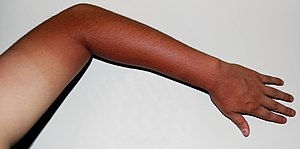
A suntanned arm showing darker skin where it has been exposed. This pattern of tanning is often called a farmer's tan.
Melanin in the skin protects the body by absorbing solar radiation. In general, the more melanin there is in the skin the more solar radiation can be absorbed. Excessive solar radiation causes direct and indirect DNA damage to the skin and the body naturally combats and seeks to repair the damage and protect the skin by creating and releasing further melanin into the skin's cells. With the production of the melanin, the skin color darkens, but can also cause sunburn. The tanning process can also be created by artificial UV radiation.
There are two different mechanisms involved. Firstly, the UVA-radiation creates oxidative stress, which in turn oxidizes existing melanin and leads to rapid darkening of the melanin, also known as IPD (immediate pigment darkening). Secondly, there is an increase in production of melanin known as melanogenesis.[84] Melanogenesis leads to delayed tanning and first becomes visible about 72 hours after exposure. The tan that is created by an increased melanogenesis lasts much longer than the one that is caused by oxidation of existing melanin. Tanning involves not just the increased melanin production in response to UV radiation but the thickening of the top layer of the epidermis, the stratum corneum.[7]
A person's natural skin color affects their reaction to exposure to the sun. Generally, those who start out with darker skin color and more melanin have better abilities to tan. Individuals with very light skin and albinos have no ability to tan.[85] The biggest differences resulting from sun exposure are visible in individuals who start out with moderately pigmented brown skin: the change is dramatically visible as tan lines, where parts of the skin which tanned are delineated from unexposed skin.[7]
Modern lifestyles and mobility have created mismatch between skin color and environment for many individuals. Vitamin D deficiencies and UVR overexposure are concerns for many. It is important for these people individually to adjust their diet and lifestyle according to their skin color, the environment they live in, and the time of year.[7] For practical purposes, such as exposure time for sun tanning, six skin types are distinguished following Fitzpatrick (1975), listed in order of decreasing lightness:
Fitzpatrick scale
The following list shows the six categories of the Fitzpatrick scale in relation to the 36 categories of the older von Luschan scale:[86][87]| Type | Also called | Sunburning | Tanning behavior | Von Luschan's chromatic scale |
|---|---|---|---|---|
| I | Light, pale white | Always | Never | 0–6 |
| II | White, fair | Usually | Minimally | 7–13 |
| III | Medium, white to light brown | Sometimes | Uniformly | 14–20 |
| IV | Olive, moderate brown | Rarely | Easily | 21–27 |
| V | Brown, dark brown | Very rarely | Very easily | 28–34 |
| VI | Very dark brown to black | Never | Never | 35–36 |
Dark skin with large concentrations of melanin protects against ultraviolet light and skin cancers; light-skinned people have about a tenfold greater risk of dying from skin cancer, compared with dark-skinned persons, under equal sunlight exposure. Furthermore, UV-A rays from sunlight are believed to interact with folic acid in ways that may damage health.[88] In a number of traditional societies the sun was avoided as much as possible, especially around noon when the ultraviolet radiation in sunlight is at its most intense. Midday was a time when people stayed in the shade and had the main meal followed by a nap,[89] a practice similar to the modern siesta.
Geographic variation
1959 map of human skin color distribution by R. Biassutti in the Von Luschan's chromatic scale for classifying skin color.
Approximately 10% of the variance in skin color occurs within regions, and approximately 90% occurs between regions.[90] Because skin color has been under strong selective pressure, similar skin colors can result from convergent adaptation rather than from genetic relatedness; populations with similar pigmentation may be genetically no more similar than other widely separated groups. Furthermore, in some parts of the world where people from different regions have mixed extensively, the connection between skin color and ancestry has substantially weakened.[91] In Brazil, for example, skin color is not closely associated with the percentage of recent African ancestors a person has, as estimated from an analysis of genetic variants differing in frequency among continent groups.[92]
In general, people living close to the equator are highly darkly pigmented, and those living near the poles are generally very lightly pigmented. The rest of humanity shows a high degree of skin color variation between these two extremes, generally correlating with UV exposure. The main exception to this rule is in the New World, where people have only lived for about 10,000 to 15,000 years and show a less pronounced degree of skin pigmentation.[7]
In recent times, humans have become increasingly mobile as a consequence of improved technology, domestication, environmental change, strong curiosity, and risk-taking. Migrations over the last 4000 years, and especially the last 400 years, have been the fastest in human history and have led to many people settling in places far away from their ancestral homelands. This means that skin colors today are not as confined to geographical location as they were previously.[7]
Social status, colorism and racism

Skin colors according to von Luschan's chromatic scale
According to classical scholar Frank Snowden, skin color did not determine social status in ancient Egypt, Greece or Rome. These ancient civilizations viewed relations between the major power and the subordinate state as more significant in a person's status than their skin colors.[93][need quotation to verify]
Nevertheless, some social groups favor specific skin coloring. The preferred skin tone varies by culture and has varied over time. A number of indigenous African groups, such as the Maasai, associated pale skin with being cursed or caused by evil spirits associated with witchcraft. They would abandon their children born with conditions such as albinism and showed a sexual preference for darker skin.[94]
Many cultures have historically favored lighter skin for women. Before the Industrial Revolution, inhabitants of the continent of Europe preferred pale skin, which they interpreted as a sign of high social status. The poorer classes worked outdoors and got darker skin from exposure to the sun, while the upper class stayed indoors and had light skin. Hence light skin became associated with wealth and high position.[95] Women would put lead-based cosmetics on their skin to whiten their skin tone artificially.[96] However, when not strictly monitored, these cosmetics caused lead poisoning. Other methods also aimed at achieving a light-skinned appearance, including the use of arsenic to whiten skin, and powders. Women would wear full-length clothes when outdoors, and would utilize gloves and parasols.
Colonization and enslavement as carried out by European countries became involved with colorism and racism, associated with the belief that people with dark skin were uncivilized, inferior, and should be subordinate to lighter-skinned invaders. This has been perpetuated[by whom?] in modern times.[97] Institutionalized slavery in North America led people to perceive lighter-skinned African-Americans as more intelligent, cooperative, and beautiful.[98] Such lighter-skinned individuals had a greater likelihood of working as house slaves and of receiving preferential treatment from plantation owners and from overseers. For example, they had a chance to get an education,[99] while darker African-Americans worked in the fields and did not get an education.[100] The preference for fair skin remained prominent until the end of the Victorian era, but racial stereotypes about worth and beauty persisted in the last half of the 20th century and continue in the present day. African-American journalist Jill Nelson wrote that, "To be both prettiest and black was impossible,"[101] and elaborated:
We learn as girls that in ways both subtle and obvious, personal and political, our value as females is largely determined by how we look. … For black women, the domination of physical aspects of beauty in women's definition and value render us invisible, partially erased, or obsessed, sometimes for a lifetime, since most of us lack the major talismans of Western beauty. Black women find themselves involved in a lifelong effort to self-define in a culture that provides them no positive reflection.[101]
A Vietnamese motorcyclist wears long gloves to block the sun, despite the tropical heat.
A preference for fair or lighter skin continues in some countries, including Latin American countries where whites form a minority.[102] In Brazil, a dark-skinned person is more likely to experience discrimination.[103] Many actors and actresses in Latin America have European features—blond hair, blue eyes, and pale skin.[104][105] A light-skinned person is considered[by whom?] more privileged and has a higher social status;[105] a person with light skin is considered more beautiful[105] and lighter skin suggests that the person has more wealth.[105] Skin color is such an obsession in some countries that specific words describe distinct skin tones - from (for example) "jincha", Puerto Rican slang for "glass of milk" to "morena", literally "brown".[105]
In India, society regards pale skin as more attractive and associates dark skin with lower class status; this results in a massive market for skin-whitening creams.[106] Fairer skin-tones also correlate to higher caste-status in the Hindu social order – although the system is not based on skin tone.[107] Actors and actresses in Indian cinema tend to have light skin tones, and Indian cinematographers have used graphics and intense lighting to achieve more "desirable" skin tones.[108] Fair skin tones are claimed[by whom?] to be an asset in Indian marketing.[109]
Skin-whitening products have remained popular over time, often due to historical beliefs and perceptions about fair skin. Sales of skin-whitening products across the world grew from $40 billion to $43 billion in 2008.[110] In South and East Asian countries, people have traditionally seen light skin as more attractive, and a preference for lighter skin remains prevalent. In ancient China and Japan, for example, pale skin can be traced back to ancient drawings depicting women and goddesses with fair skin tones.[citation needed] In ancient China, Japan, and Southeast Asia, pale skin was seen as a sign of wealth. Thus skin-whitening cosmetic products are popular in East Asia.[111] Four out of ten women surveyed in Hong Kong, Malaysia, the Philippines and South Korea used a skin-whitening cream, and more than 60 companies globally compete for Asia's estimated $18 billion market.[112] Changes in regulations in the cosmetic industry led to skin-care companies introducing harm-free skin lighteners. In Japan, the geisha have a reputation for their white-painted faces, and the appeal of the bihaku (美白), or "beautiful white", ideal leads many Japanese women to avoid any form of tanning.[113] There are exceptions to this, with Japanese fashion trends such as ganguro emphasizing tanned skin. Skin whitening is also not uncommon in Africa,[114][115] and several research projects have suggested a general preference for lighter skin in the African-American community.[116] In contrast, one study on men of the Bikosso tribe in Cameroon found no preference for attractiveness of females based on lighter skin color, bringing into question the universality of earlier studies that had exclusively focused on skin-color preferences among non-African populations.[117]
Significant exceptions to a preference for lighter skin started to appear in Western culture in the mid-20th century.[118] Though sun-tanned skin was once associated with the sun-exposed manual labor of the lower class, the associations became dramatically reversed during this time—a change usually credited to the trendsetting Frenchwoman Coco Chanel (1883-1971) presenting tanned skin as fashionable, healthy, and luxurious.[119] As of 2017, though an overall preference for lighter skin remains prevalent in the United States, many within the country regard tanned skin as both more attractive and healthier than pale or very dark skin.[120][121][122] Western mass media and popular culture continued[when?] to reinforce negative stereotypes about dark skin,[123] but in some circles pale skin has become associated with indoor office-work while tanned skin has become associated with increased leisure time, sportiness and good health that comes with wealth and higher social status.[95] Studies have also emerged indicating that the degree of tanning is directly related to how attractive a young woman is.[124][125]



